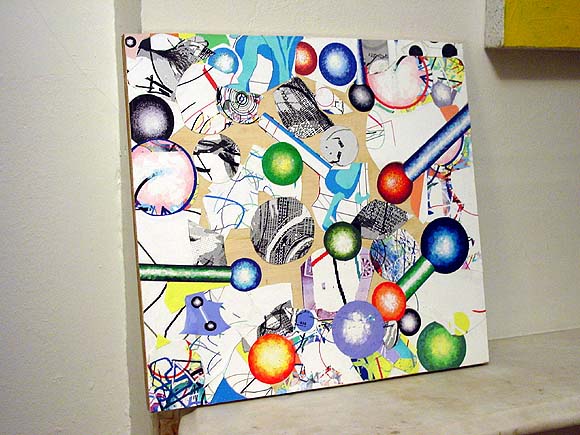thumbnail views of additional work (not linked to images on this page)
View current page
...more recent posts

Momenta Art in Williamsburg has its annual benefit coming up and I'm donating a piece. Jeez, the last time I did this was four years ago, shortly after I started this blog. Here's to both of us still being around in the world o'ephemera that is the art scene. I tried something new with the piece above, which is gluing the paper--many little cut out pieces printed with "drawn elements" from my home computer--directly onto a piece of plywood. I was expecting to struggle more but this came together fairly quickly--I'm happy not to drag out the process. Now, if I was Fred Tomaselli I'd collector-ify the piece by pouring polyurethane goo all over it, but I kind of hate that restaurant table decoupage look so I think I'll just give it a light coat of matte fixative and call it done. I like seeing the texture of the paper clinging to the wood--I also left some wood showing on the front, which I didn't expect to do. All this could change tomorrow but I only have a few more days to screw with it.

These are older pieces but the framing changes them quite a bit.
Draft of a written statement about my current work (too wordy for main page).
About the art. Moody’s work is hand-drawn in older paint programs using a mouse or stylus and abused at the printer stage, as in run through multiple times, then cut up and collaged into taped-together patchworks. This method of working goes against the grain of, or "problematizes," the computer (as the '80s theorists used to say) by introducing techniques of painstaking individualized production to an instrument designed for quick, cheap mass production. Instead of succumbing to commercial pressure for state-of-the-art upgrades, the artist moves entropically backward to older, "downgraded" programs. Recurring subjects are the hopeful, jouissant motifs of early Modernism (synthetic cubism, expressionism)--another willful regression that could be mistaken for simple conservatism--combined with the graphic cliches from the early years of computing, such as networks of bulbous molecules and spheroids. Ultimately the subject is not "the machine" but human resistance and choice in the face of the myriad controlled and managed environments of technocracy.

F-Factor 2, 2003-4, ink on paper, 54" X 49". Below: 2 details (closeup and super closeup).



"Synthetic Synthetic Cubism"? Yeah, it's a misnomer--Synthetic Cubism was basically late, illustrational Cubism but this current work I'm doing has more in common with the early, incomprehensible Analytical phase. The director of a nonprofit gallery that only shows overtly political work visited the studio a couple of years ago and dismissed pieces of this ilk as "just Kandinsky" (also not Synthetic Cubism, but close enough). I take that as a compliment, since last I heard Mr. K. worked with paint (with all its history and baggage) and these are entirely done with a computer, printer, scissors, and tape. Masquerading as somewhat stylish drawings and paintings, they are simulacra--"robot Kandinsky." Unlike Mike Bidlo and the appropriators, though, I'm not making facsimiles of known early Modernist works. I'm actually still interested in the puzzles of representing a "vortex" or "field." How much does that "pure" field reflect the stamp of the imaging program? Can that programming be circumvented or thwarted? What is inherently "cyber" and what belongs to the pre-technological past? Those are some of the issues here.












Work in progress; the back side of a piece prior to taping. It looks kind of elegant as a drawing.



Recent drawings, studio installation view.
Larger views of some of the drawings are here (click thumbs for enlarged versions).
